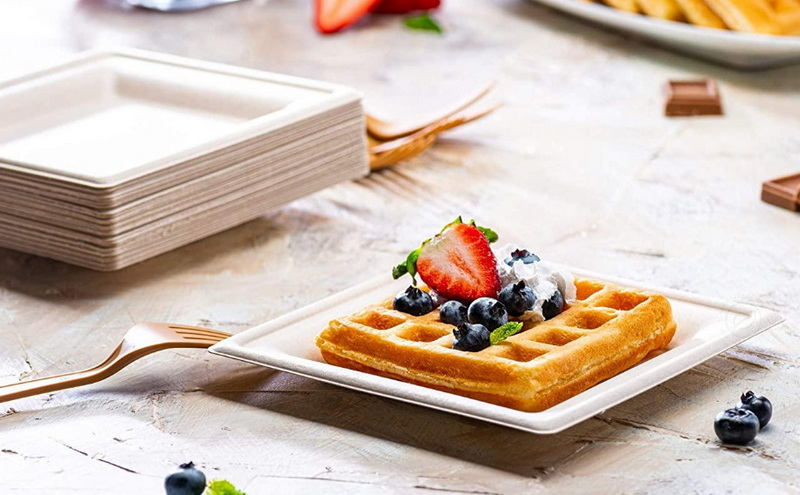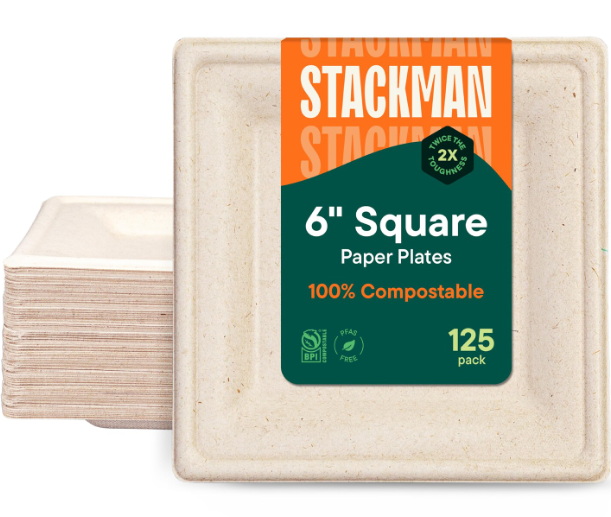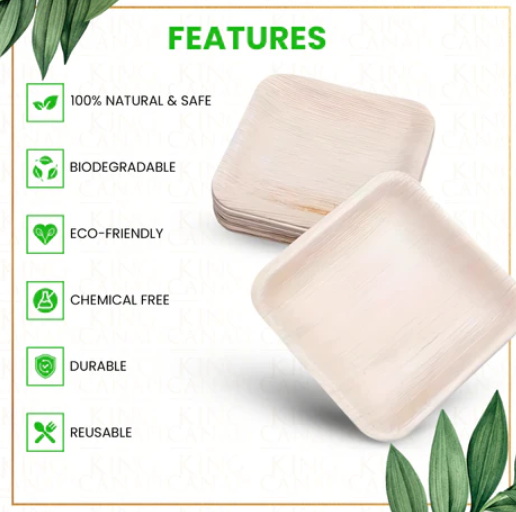
Content Menu
● Introduction to Square Disposable Plates
>> Benefits of Square Disposable Plates
● Materials Used in Square Disposable Plates
>> 1. Plastic Plates
>> 2. Paper Plates
>> 3. Compostable Materials
● Environmental Impact of Square Disposable Plates
>> 1. Plastic and Paper Plates
>> 2. Compostable Plates
● Benefits of Biodegradable Square Disposable Plates
● Practical Tips for Choosing Eco-Friendly Square Disposable Plates
● Case Studies and Success Stories
● The Role of Consumer Awareness
● Sustainable Practices in Event Planning
● Future of Sustainable Tableware
● Conclusion
● FAQ
>> 1. What materials are eco-friendly square disposable plates made of?
>> 2. How do compostable plates impact the environment?
>> 3. Can all square disposable plates be composted?
>> 4. What are the benefits of using biodegradable square disposable plates?
>> 5. How can I ensure proper disposal of compostable square plates?
● Citations:
In recent years, the demand for eco-friendly and biodegradable products has increased significantly, especially in the context of disposable tableware. Square disposable plates have become a popular choice for events and daily use due to their convenience and aesthetic appeal. However, the question remains: are these plates truly eco-friendly and biodegradable? This article will delve into the materials, environmental impact, and benefits of using square disposable plates, exploring whether they align with sustainable practices.

Introduction to Square Disposable Plates
Square disposable plates are widely used for their convenience, cost-effectiveness, and modern design. They are ideal for large events, such as weddings and corporate meetings, as well as casual gatherings like backyard BBQs. The square shape provides better stability and space efficiency compared to traditional round plates, making them a favorite among event planners and homeowners alike.
Benefits of Square Disposable Plates
1. Convenience: These plates are lightweight, stackable, and easy to transport, reducing logistical stress for event organizers.
2. Cost-Effectiveness: They are generally cheaper than traditional dinnerware, saving on both purchase and cleanup costs.
3. Aesthetic Appeal: The square design offers a contemporary look that enhances food presentation, making them suitable for upscale events.
Materials Used in Square Disposable Plates
Square disposable plates can be made from various materials, each with its own environmental implications:
1. Plastic Plates
Plastic plates, often made from polystyrene or polypropylene, are non-biodegradable and contribute significantly to plastic pollution. Their production requires fossil fuels and generates substantial greenhouse gas emissions. Once used, these plates can take hundreds of years to decompose, leading to landfill overflow and harming wildlife.
2. Paper Plates
Paper plates, while seemingly eco-friendly, often have environmental drawbacks. They require tree cutting, water, and energy for production. Many paper plates are coated with chemicals like PFAS (Forever Chemicals), which hinder their compostability and pose health risks.
3. Compostable Materials
Compostable plates are made from organic materials such as sugarcane bagasse, bamboo, or palm leaves. These plates are biodegradable, breaking down into nutrient-rich soil within a few months when composted properly. They offer a sustainable alternative to traditional disposable plates.
Environmental Impact of Square Disposable Plates
The environmental impact of square disposable plates largely depends on their material composition:
1. Plastic and Paper Plates
- Pollution: Plastic plates contribute to ocean pollution and landfill overflow, while paper plates, if coated, can release harmful chemicals during decomposition.
- Resource Consumption: Production of these plates requires significant resources, including fossil fuels and water.
2. Compostable Plates
- Biodegradability: Compostable plates decompose quickly, reducing landfill waste and supporting sustainable agriculture.
- Carbon Footprint: Their production often involves less energy and emits fewer greenhouse gases compared to traditional plastics.
Benefits of Biodegradable Square Disposable Plates
Choosing biodegradable square disposable plates offers several environmental and practical benefits:
1. Reduced Waste: These plates decompose naturally, minimizing landfill waste and pollution.
2. Lower Carbon Footprint: Production from renewable resources reduces reliance on fossil fuels and greenhouse gas emissions.
3. Non-Toxic: They do not release harmful chemicals during decomposition, ensuring a safer environment.
Practical Tips for Choosing Eco-Friendly Square Disposable Plates
When selecting square disposable plates, consider the following:
1. Material: Opt for plates made from compostable materials like sugarcane bagasse or palm leaves.
2. Certifications: Look for third-party certifications ensuring the product is eco-friendly.
3. Disposal: Ensure that composting facilities are available in your area for proper disposal.

Case Studies and Success Stories
Several businesses have successfully transitioned to using eco-friendly square disposable plates, achieving significant environmental benefits. For instance, a catering company shifted to using bagasse disposable plates, resulting in a substantial reduction in waste and cost savings. This transition not only reduced packaging waste by thousands of tons annually but also saved the company nearly $4,000 per year by cutting down on single-use disposable waste.
The Role of Consumer Awareness
Consumer awareness plays a crucial role in driving demand for eco-friendly products. By choosing sustainable options like compostable square disposable plates, consumers can influence manufacturers to produce more environmentally friendly products. This collective effort can lead to a significant reduction in plastic waste and promote sustainable practices across industries.
Sustainable Practices in Event Planning
Event planners are increasingly incorporating sustainable practices into their operations. Using square disposable plates made from compostable materials is a key strategy in reducing environmental impact. These plates not only enhance the aesthetic appeal of events but also contribute to a greener operation by minimizing waste and supporting renewable resources.
Future of Sustainable Tableware
The future of sustainable tableware looks promising with advancements in biodegradable materials. As technology improves, we can expect more durable and affordable eco-friendly options to emerge. This shift towards sustainable tableware is part of a broader movement towards conscious consumption and reducing plastic pollution.
Conclusion
In conclusion, not all square disposable plates are created equal in terms of eco-friendliness and biodegradability. While traditional plastic and paper plates have significant environmental drawbacks, compostable plates made from materials like sugarcane bagasse or palm leaves offer a sustainable alternative. By choosing biodegradable options and ensuring proper disposal, individuals can significantly reduce their environmental impact.

FAQ
1. What materials are eco-friendly square disposable plates made of?
Eco-friendly square disposable plates are typically made from compostable materials such as sugarcane bagasse, bamboo, or palm leaves. These materials are biodegradable and can decompose into nutrient-rich soil.
2. How do compostable plates impact the environment?
Compostable plates reduce landfill waste and support sustainable agriculture by decomposing into organic matter. They require less energy and emit fewer greenhouse gases during production compared to traditional plastics.
3. Can all square disposable plates be composted?
Not all square disposable plates can be composted. Only those made from certified compostable materials like sugarcane bagasse or palm leaves can be composted. Others, such as plastic or coated paper plates, cannot be composted and contribute to pollution.
4. What are the benefits of using biodegradable square disposable plates?
Biodegradable square disposable plates reduce waste, have a lower carbon footprint, and are non-toxic. They support sustainable practices and minimize environmental pollution.
5. How can I ensure proper disposal of compostable square plates?
To ensure proper disposal, check if commercial composting facilities are available in your area. If not, these plates can still be disposed of in landfills, where they will break down into clean biomass, though composting is preferred for minimal carbon emissions.
Citations:
[1] https://www.innaturepack.com/why-square-disposable-plates-are-perfect-for-your-event/
[2] https://www.goodstartpackaging.com/tableware/plates/
[3] https://palmware.in/leaf-plates-plastic-plates-environmental-impact/
[4] https://www.freshtableware.in/post/how-to-use-disposable-tableware-sustainably
[5] https://www.bioleaderpack.com/best-disposable-plates-for-hot-food-warm-dinner/
[6] https://greenpaperproducts.com/blog/the-importance-of-eco-friendly-disposable-tableware-for-food-businesses
[7] https://smartyhadaparty.com/blogs/home/plastic-vs-paper-plates-which-is-better
[8] https://foliumware.com/the-environmental-impact-of-disposable-tableware-a-comprehensive-guide/
[9] https://greenpaperproducts.com/collections/compostable-plates
[10] https://www.webstaurantstore.com/guide/621/disposable-dinnerware-buying-guide.html
[11] https://www.green-sapling.com/blogs/news/the-benefits-of-utilizing-eco-friendly-disposable-tableware-at-parties
[12] https://www.biopak.com/au/plates-trays
[13] https://smartyhadaparty.com/blogs/home/understanding-biodegradable-disposable-dinnerware
[14] https://www.mdpi.com/2071-1050/17/4/1434
[15] https://www.sumkoka.com/disposable-plate-size-guide.html
[16] https://diyecobox.com/eco-tableware-benefits/
[17] https://www.alibaba.com/product-detail/Customization-Biodegradable-Raw-Materials-Bagasse-Disposable_1601035663640.html
[18] https://arbhuenterprises.com/the-environmental-benefits-of-using-leaf-plates-for-your-meals-2/
[19] https://sust.hkust.edu.hk/life-cycle-lab/perspectives-commentary/plastic-ban-what-now
[20] https://ambican.com/blog/comparing-materials-which-paper-plates-are-most-sustainable/

















